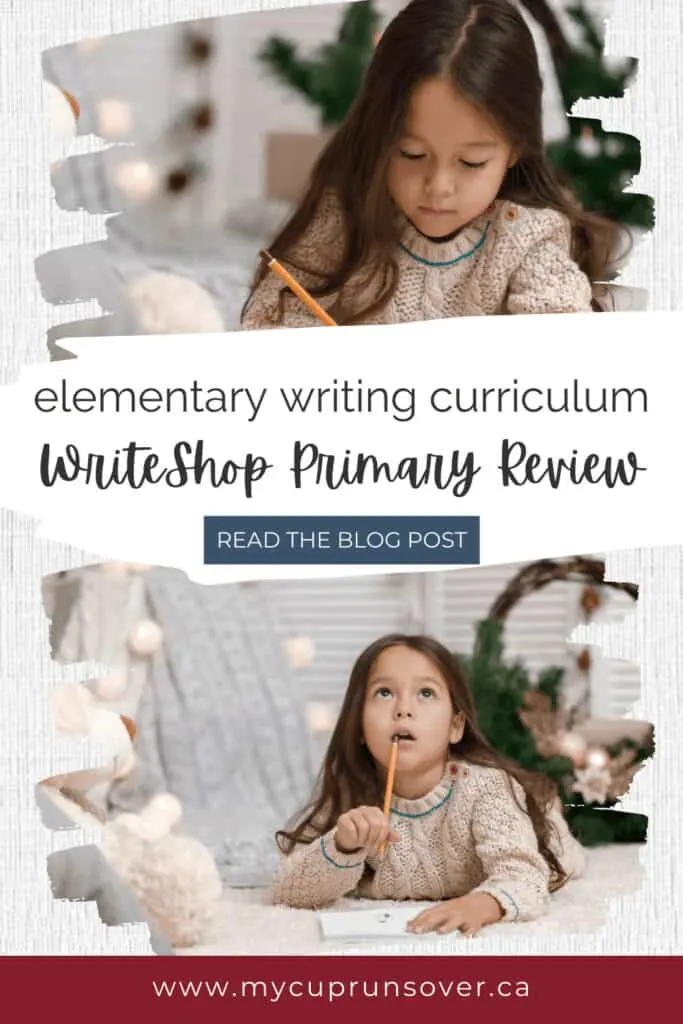Early elementary is a great time to introduce story writing to kids. With gentle instruction from parents and fun activities, kids in grades one to three can develop an early enthusiasm for writing. This review of the WriteShop Primary Book C elementary writing curriculum will give you a sneak peek into the process we’re currently using to introduce writing skills to our seven-year-old.

Affiliate disclosure: This post may contain affiliate links, which means we may receive a commission if you click a link and purchase something that we have recommended. Please read our disclaimer for more details.
How to Get Kids Excited About Writing
Storywriting is a favorite activity in our homeschool. Even our youngest, at four, loves to dictate stories for his sisters or me to write down.
But a love of writing does not always come naturally. While some kids develop this interest on their own, others need to see some fruits of their labor (i.e. enjoying a story they’ve written themselves) before they’re convinced it’s a worthwhile endeavor.
So how do you get kids excited about writing?
In my experience, the most important first step is to remove the pressure. As parents and educators, we tend to fall into the trap of expecting too much too soon from our burgeoning writers. We want proper spelling, legible penmanship, interesting ideas, sentences that flow together. The pressure to get all of these pieces right at the same time is more than most young children can handle, and we run the risk of turning them off writing if we push them too hard.
Think of a baby learning to walk. Each skill must be conquered incrementally. First, they must learn to pull themselves up to a stand, and they practice this skill relentlessly in their cribs when they’re supposed to be napping.
Then they master the art of cruising around the coffee table, using their hands to steady themselves as they make their first awkward shuffles.
And one day, they take that first tentative step away from the safety net of stable furniture, letting go slowly to test the waters of unsupported standing.
And then they fall.
And we cheer. Not because they walked across the room, but because they tried.
They made progress.
They moved one step further, literally, than they had the day before. And we know that it’s an accomplishment.
The next day they might take two or three steps, but it will be weeks before they’re tromping around the room with the confidence of Terk in the Jungle Book.
And even then, they’re still going to be clumsy for years. They’ll still fall more than the average person, lose their balance, and get tired after walking five minutes.
We accept all of this as a normal part of development.
And yet, many of us tend to expect a different type of progress from kids who are learning to write.
I know I am so guilty of this. During a single writing session with my daughter, I will be tempted (multiple times) to correct her pencil grip, the orientation or size of a letter, her spelling, her capitalization and punctuation, her word choice, her ideas, and her complaints that she doesn’t feel like writing.
This is how you remove the excitement from writing.
But, by acknowledging that learning to write is at least as difficult as learning to walk, and adjusting our expectations accordingly, we can make writing fun again for kids.
A Writing Approach that Lowers Pressure While Improving Results
Over the past ten years, I have tried countless language arts curricula with my four children. We’ve used comprehensive programs that cover all aspects of written language, and skill-specific programs that focus on a single developmental area such as spelling or grammar.
We’ve had a love-hate relationship with most of them.
Some were too formal, others too relaxed. Some pushed too hard, while others didn’t push at all.
And somehow, the kids have muddled through it all and still developed a love of writing.
What has worked best for us has always been choosing interesting writing projects and pursuing them for the joy of it, rather than just doing it for the sake of producing another piece of writing.
While these projects haven’t always emerged from the use of a writing curriculum, many of them have.
This year, I’ve seen my youngest daughter grow exponentially in her enthusiasm for writing as we work through the WriteShop Primary curriculum (Book C).
With fun hands-on activities that make writing strategies more tangible, this junior book eliminates stress for the child and allows her to put together new concepts in a way that makes sense to her.
Here’s a fun video of her reading her first WriteShop assignment.
(As an aside, the Future Bestselling Author hoodie for kids is available here.)
Teaching Writing to Elementary Students with WriteShop Primary Book C
The lesson plans in The WriteShop Primary Book C writing program follow a consistent pattern but are designed to be as flexible as possible. The ten lessons include topics such as planning a story, writing a mystery, self-editing, journal writing, descriptive writing, and simple reports. Each one is best completed over the course of three weeks, making this a full school-year program.
Although kids using the WriteShop C curriculum do produce a lot of written work over the course of the year, what my daughter seems to appreciate most about it are the hands-on projects that support the writing process.
Using an ongoing analogy of a detective, WriteShop encourages kids to unpack the details of stories they read and write. Who is it about? Where and when does it take place? What problem does the protagonist face? How will they solve it? Kids return to these questions throughout each lesson as they analyze favorite stories and plan their own works.
My daughter also enjoys keeping a “top-secret detective file” where she stores the information she uncovers. It makes her take a special interest in the work she’s doing.
Other activities and projects included in WriteShop C are:
- Time capsule
- Spinner spelling game
- Graphic organizer kite
- Venn diagrams
- Travel poster
- 3-panel story board
Even from the first lesson, student writing projects include short stories that are up to ten sentences long. As most kids at this grade level won’t be able to write that much at one time, WriteShop encourages parents to allow students to dictate while parents help with some of the actual writing. We usually alternate with one or two sentences each.
I also appreciate that WriteShop encourages families to spend a longer amount of time on a small number of writing projects, rather than rushing to complete dozens of writing projects and never really putting in the time and effort to see each one through to fruition.
Students learn from a very young age the value of editing and revision, as well as creating a polished final draft. My daughter loves developing her design skills in Canva, which she uses to illustrate her stories with photos.

On the flip side, there are a couple of aspects of WriteShop Book C that I would change if I could.
I find this to be a very hands-on program for parents. There is a significant amount of prep work involved and you are actively working with your child at every stage of the process. If you aren’t there to help them, progress doesn’t happen. This can be challenging when you’re teaching a big family.
The parent handbook is extensive, coming in at over 250 pages. In some ways, this is amazing. It leaves no stone overturned and gives you ample resources, ideas, and explanations to enable you to teach writing to your kids, even if you don’t feel like a strong writer yourself.
However, for a mom like me who feels quite confident in teaching writing and doesn’t have time to read all of that information, the manual can sometimes feel like information overload as I try to zero in on exactly what I need to read to prep for the upcoming lesson.
Although I enjoy all of the activities, I find myself choosing them selectively to fit into our schedule and to reduce the amount of prep work involved.
There is always a time/money trade-off when choosing a homeschool curriculum. The more money you spend, the less time you usually have to spend prepping and vice versa.
While I appreciate that WriteShop is able to keep the cost of their products quite low by having parents DIY a lot of the activity prep, I would prefer to have the option to purchase a kit that includes everything I will need for the activities so I know I can just open the book and teach when the time arises.
One solution I’ve found for this is to use my own writing prompt resources as part of my writing center kit. For example, when my daughter has to come up with all of the elements of her next story, I pull out the story selector game pages I’ve printed out to help her get her creative juices flowing.
Nonetheless, I can’t deny that my daughter thoroughly enjoys the curriculum and begs to work on it every day. If that’s not a homeschool win, I don’t know what is!

Sophie Agbonkhese is a writer, homeschooling mother of four, and a recovering overachiever (who occasionally relapses). She is the founder of My Cup Runs Over, a site dedicated to helping busy women simplify and enrich their lives. When she’s not writing or debugging websites, Sophie spends her time reading, dancing, bullet journaling, reading, gardening, listening to audiobooks, and striving fruitlessly to have a clean house for at least five minutes.

